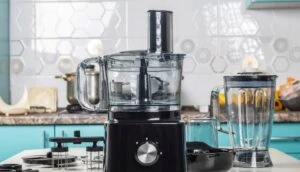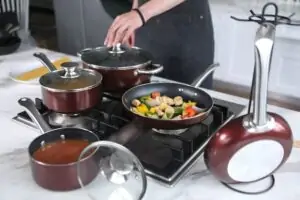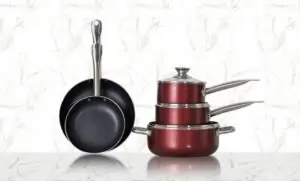Looking for an excellent stand mixer for kneading bread dough? Do you want an appliance that can deal with more than one loaf at a time? Has the best features to offer? You’ve come to the right place!
We have compiled a list of the best-selling stand mixers to get well-kneaded bread dough and make your bread-making experience easier and more pleasant.
Quick View
Top Recommended: Ankarsrum Electric Stand Mixer
Best Budget-Friendly: Hamilton Beach 6 Speed Electric Stand Mixer
Best Premium: Wolf Gourmet High-Performance Stand Mixer
Best Runner-Up: KitchenAid Professional 600 Series
1. Ankarsrum Electric Stand Mixer
Our top pick and recommendation for the best bread mixer is the Ankarsrum Electric Stand Mixer.
This stand mixer performs great for baking professionals. It comes with a large 7.5-quart stainless steel bowl that can hold up to 18 cups of flour, which means 10.75 pounds of dough for bread, yielding 5-7 loaves of bread.
Its powerful 600-watt motor can knead large amounts of dough without straining or gnashing gears and removes the chance of smoke escaping out of your machine. It will not overheat.
This Ankarsrum electric stand mixer has two attachments, including a dough scraper that folds the dough and one roller that performs the classic kneading/massaging function. It also comes with other accessories.
It is visually appealing and ideal for larger bread and dough recipes. The stand mixer is designed to provide performance and durability, kneading each time flawlessly.
This appliance has an elegant stainless steel design and gives a classic look to the kitchen. Unlike traditional mixers with a unit spin attachment, this mixer also has a rotating bowl.
Pros
- 600-watt motor
- 5 Quart stainless steel bowl
- Removable power cord
- Different colors are available
- 7-year warranty
Cons
- Need to follow the directions carefully to make sure you use the attachments correctly – don’t/can’t rely on your intuition
- It is not suitable for use with lighter doughs or non-bread recipes
- It comes at a high cost
2. Hamilton Beach 6 Speed Electric Stand Mixer
As a budget-friendly option, this 300-watt Hamilton Beach 6-Speed Electric Stand Mixer can efficiently mix bread dough or batters used for quick bread.
The Hamilton Beach-6 is great for softer doughs and smaller batches. It comes with a mixing function that allows the attachment to rotate around the bowl for even mixing. The model has a 3.5-quart capacity stainless steel mixing bowl, wire whisk, dough hook, and a plastic paddle.
The most significant feature of this dough mixer is the folding option (combined with the six speeds this appliance offers). This feature is handy when folding delicate ingredients and mixing ingredients slowly to avoid messes while you mix.
Pros
- 300 watts of power
- 5-quart mixing bowl
- 6-speed options
- The head tilts up to assist in bowl removal
- Folding setting for delicate mixing
- Affordable
Cons
- No splash guard
- The paddle is made of plastic
3. Wolf Gourmet High-Performance Stand Mixer
The Wolf Gourmet stand mixer is a high-end machine that comes with an enormous capacity of 7-quarts and an impressive 500-watt motor that can handle eight tonnes of dough once.
The Wolf Gourmet High-Performance Stand Mixer has a bowl lift with Wolf’s unique design that allows the bowl to lift and lower using just a simple twist of the bowl’s handle.
Bakers will appreciate the excellent control they can maintain over the mixing speed due to the speed dial that can be adjusted and a pulse function that allows gradual adding of ingredients to the mix.
The mixer comes with a whisk, a flat beater, and a dough hook. All of these parts are dishwasher safe, which means easy cleanup. If you already have Wolf appliances, you’ll be able to appreciate the design of this mixer since the red knob and brushed-finish match nicely with the other Wolf appliances.
The mixer does not show any signs of stress, overheating, excessive shaking, or noise. While other models might “walk” across countertops with extreme mixing, however, Wolf Gourmet is designed to remain in place.
Pros
- 7-quart bowl provides plenty of room
- 500-watt motor
- Speed dial feature
- Pulse function
- Includes dough hook, whisk, flat beater, and splash/pouring shield
Cons
• More industrial than stylish
4. KitchenAid Professional 600 Series
The KitchenAid Professional 600 Series Stand Mixer is another excellent option for your kitchen counter. KitchenAid offers appliances that are attractive, modern, applicable, and budget-friendly.
This model has a strong motor compared to other KitchenAid mixers. It also features a bowl lift mechanism, giving the device enough stability to handle large amounts as well as dense and thick mixtures.
The professional 600 series also features an auto shut-off, a soft start, an electronic speed sensor, and a locked rotator protection device.
In addition, this KitchenAid stand mixer has a multipurpose attachment hub that offers 15 options. The machine gears are made from rugged metal, and this best bread mixer has a 575W motor. Its most attractive feature is the presence of an adjustable screw that allows it to lower or raise the height of beaters.
Overall, the KitchenAid Professional 600, 6-quart bread mixer is functional and versatile. Also, the stainless steel bowl has a handle, making lifting easy. It’s dishwasher safe and easy to clean. This KitchenAid stand mixer is the perfect appliance to have in the kitchen if you enjoy homemade bread.
Pros
- 575 watts of power
- Metals gears
- Ten-speed options
- 6-quart steel bowl
- lift/lower bowl design
- Available in 10+ colors
Cons
- Burnished beaters
- The dough hook has to be hand washed
- Makes loud noise
- Only 1-year warranty
Why Choose a Bread Mixer?
Stand mixers make mixing or baking just about everything much simpler. They’re beneficial for a baking recipe that calls for dense dough, like pizza dough or bread dough, or recipes that require more complex mixing.
Stand mixers usually have large mixing bowls and various attachments made for particular mixing. For example, you’d have a different tool to make meringue compared to what you’d use to make bread.
Because a bread mixer is stationary, it can mix your ingredients effortlessly while you continue working on gathering the other ingredients.
The only significant drawback of a stand mixer is its dimensions and weight. If you are short on storage space in your kitchen or don’t have ample counter space, you may feel resentful about the task of bringing the heavy stand mixer inside and out of the kitchen cabinet.
Benefits:
- Stand mixers are much more efficient than hand mixing or hand mixers
- These units mix faster and more efficiently. Since it’s stationary, you can mix it up and then leave it to focus on other tasks
- Stand mixers typically come with (or you can purchase) different accessories specifically designed to provide the highest quality results for different kinds of mixing
- Stand mixers can allow you to prepare bread, pasta, ravioli, sauce, juice, and even ice cream or mill grains
Keep in Mind:
- Stand mixers are usually pricey
- Uses up a lot of counter space
- Takes additional kitchen storage space
- Sometimes, they are challenging to wash
Overall, the best bread mixer can make every bread recipe simple, faster, and much more effortless.
However, when using the best stand mixer to make bread dough, it is crucial to use the correct kneading technique to produce yeast bread.
Making bread dough requires mixing ingredients with air; the air is incorporated, and the gluten is formed. This network of gluten created through the kneading process allows the dough’s volume to increase throughout its proofing phase, the final rise which takes the longest.
Few people like mixing the ingredients and then kneading the dough with their hands; this can take 25 minutes and requires great physical strength.
A stand bread mixer comes in to lessen the effort and time. With the help of a mixer, you can knead the dough within 8-10 minutes.
Furthermore, the most crucial benefit of using a stand mixer to make bread is its texture is the same as when you knead it using your hands. The desired consistency is achieved without worrying about whether the dough is adequately mixed or not. Additionally, you don’t need to work at all.
Stand mixers are also helpful in making gluten-free bread and all kinds of yeast bread. They can meet the needs of everyone.
Which Stand Mixer Is Ideal For Bread?
There are various performance levels among stand mixers. Each level offers a different frequency and capacity for baking. Therefore, you need to consider the following points to get the best suited stand mixer for you.
Light Duty Stand Mixers
They are designed to cater to lightweight jobs for infrequent bakers who like baking a cake or cookies once in a blue moon. So, if you are not an avid baker, this one is clearly not for you.
Medium Duty Stand Mixers
If you consistently enjoy diverse baking tasks but are not profoundly involved in bread making, the medium-duty mixers are best suited for you.
Heavy-Duty Stand Mixers
A heavy-duty mixer is a far better match for frequent bread makers. Bread doughs are considered heavier doughs and require intensive kneading, so that’s why these are best for enthusiastic bread makers.
So, if bread making is your area of expertise and you need to make it daily without compromising on the quality of beard dough, consider a heavy-duty mixer, which meets the following criteria:
- Has at least 400 watts or more of power
- Offers a slow start feature to avoid ingredients from flying all over the place
- Multiple speed options
- Offers a 5 quart or bigger capacity stainless steel bowl
- Ideally, embrace all-metal gearing
- Has a warranty
Stand Mixer or Bread Machine
Stand mixers work well for home bakers. However, if you bake frequently and heavily or need to have two or more loaves of bread ready every day, you should definitely consider a stand mixer.
It’s also suitable for the other bakers who enjoy the bread-making process and would love more control over how the bread turns out.
Another feature of the best bread mixer is that it assists when kneading bread dough to perfection. It takes a lot of the elbow grease out of the process.
Once you get a well-kneaded dough, you can move on to making your bread the way you like.
On the flip side, using a bread machine is a relatively simple process. All you need to do is put all of the ingredients into it, choose the right settings, and you are all set. It involves slight exertion on your end and naturally delivers pleasant, consistent results.
It is user-friendly, saves time, and offers you a fresh homemade loaf of bread daily. The downside to a bread machine for some individuals is that it only makes one bread loaf at a time.
What to Look For in a Bread Mixer
There are some aspects to be aware of when choosing the best stand mixer to make bread.
High Power
Higher wattage means an electric mixer that can handle any dough, including the thicker, heavier dough. A greater variety of speeds mean you can mix anything.
For bread dough, any machine lower than 500W will not suffice for daily use. You’ll need it to be at least 575-600 watts to be able to endure the entire kneading process without any strain or the possibility of the motor overheating.
Materials
The design should also include metal mechanisms instead of plastic. This ensures that the gears and mechanisms are robust enough not to bend or break during each kneading session.
Mixing Action
Two movements distinguish stand mixers from other mixers:
- Planetary action: The mixing attachment (whip and dough hook) revolves around the bowl, and it comes into contact with the bowl and its sides; this means that all ingredients are completely integrated and mixed. The motion is comparable to planets rotating around the sun.
- Stand mixers with two beaters: (they include two dough hooks) They are the classic models where the bowl spins around the counter-clockwise direction, i.e., in the opposite direction of the beaters, so If you’ve had one, you will know that one has to scrape around the edges of the bowl to ensure the ingredients have been integrated completely
Speed Settings
Different kinds of food require different rates of mixing. The majority of hand and stand mixers come with a range of speeds, typically between 3 and 12 choices.
All mixers must have a “slow start” setting that makes it simple to add flour and other ingredients to the mix without creating an enormous mess. A majority of models will have the speed needed to create a meringue. Many bakers are capable of making meringue with at least three speeds. However, if you’re determined and want to bake with extreme accuracy, choosing an appliance with more incredible speeds could be worth it.
Bowl Size
If you’re planning on baking for many people, It is evident that a giant bowl is what you need to be looking for.
A bowl of 4 quarts is not the best option when you intend to make several loaves of bread simultaneously. However, it’s enough for a family of four and can work for single individuals.
A shallow, wide bowl is also more beneficial because it is easier to scrape down your bowl’s sides much more quickly, and ingredients can be added with ease, but taller bowls are the most used and are considered the most common.
Stability
Stand mixers like to move around when they are kneading bread dough. This can be hazardous because the machine can drop off the counter during use, or, at best, it can be a hassle to have to stand by it and keep it in place as it does its job.
For these reasons, stability is essential. If your mixer is not sturdy enough on its own, then it should be designed to provide stability, such as suction cups on the bottom of the machine that stick to the surface.
Attachments
Additional attachments allow you to expand your mixer’s uses.
Kitchen mixers typically come with these three most popular attachments:
- Dough Hook: This is the type of attachment that’s usually in a c-shape or spiral and is used to make anything that needs mixing, such as bread or pizza dough.
- Wire Whip: Sometimes referred to as a balloon whisk, a wire whip is for the whipping motion that creates whip cream, frosting, and meringue.
- Flat Beater: The flat beater is the most frequently used tool for bakers as it is the preferred option for cookie dough, cake batters, and mashed potatoes.
Some have pouring shields, which allow you to easily add more ingredients as mixing without making a mess.
For chefs/individuals who are more adventurous. There is an array of other accessories, such as:
- Food grinder
- Fruit and vegetable strainer
- Pasta roller
- Sauce attachment and juicer
- Ravioli maker
- Slicer/shredder
- Ice cream maker
- Sausage stuffer
- Grain mill
Tip: If you consider adding additional attachments over time, purchasing an instrument that works with all your interested attachments is essential. Searching for attachments is simple since they’re readily available on the internet.
Price
Even if you’re looking for a budget-friendly option, we’ve picked a stand mixer at an affordable price for you, which is excellent in making dough. Yet, keep in mind that stand mixers are among the most expensive kitchen appliances you can buy.
The price varies widely. There are stand mixers priced at less than $100. However, some cost more than $400. It’s a big difference, so take your time choosing the best stand mixer to use in your kitchen.
Some are extremely expensive, so you may need to budget more money if you need a top-quality model.
How to Identify the Best Bread Mixer
In summary, the most effective stand mixer has the following characteristics:
- Motor with enough power to handle any type of dough, without a struggle
- A durable, hard-wearing mechanism that doesn’t wear out when mixing dough over and over again
- Variable speed settings to avoid over-kneading
- Stable and heavy enough to remain in place while mixing dough
- S-shaped hook instead of C-shaped hook to promote the proper mixing
- Multipurpose design that permits small and large doughs to be made into a ball
- A large mixing bowl for dough’s rise
Conclusion
The recommendations mentioned above will help you and allow you more control over the final product. However, before buying a bread mixer, keep in mind the amount of time you spend baking, the budget, and whether you’re looking for more options or features like a digital screen in it, you may pick a product that can improve your bread-making skills beyond the limits.















